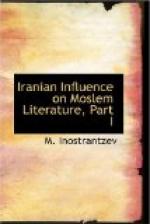[Sidenote: Corrupt texts and faulty translations.]
Says Musa Ibn Isa al Kesravi in his book: I saw the Book which is called the Khoday Nameh and which is the Book which when it was translated from Persian into Arabic was entitled Kitab al Muluk al Fars. I carefully examined the copies of this Book and looked through the narratives in them, and I found them in disagreement with each other so that I could not find even two copies which agreed with each other, and this was on account of the doubts in the minds of the translators who turned from one writing into another.
[Sidenote: Mobed Behram the historian.]
And turning back to what I have related in the previous chapter as regards the chronology [of the Persians], I relate what has been stated by Behram son of Mardanshah, Mobed of the district of Shabur in the province of Fars. Says Behram the mobed: I collected together a little over twenty copies of the book called Khoday Nameh and I put together properly the chronology of the kings of Persia from the times of Kayumarth, the father of mankind, till the last days when the empire was transferred from them to the Arabs.
[Hamza describes the dress of the kings according to a book in which they were depicted just before their death. And he gives the buildings which each of them erected, especially the fire-temples they established along with the villages on the produce of which they were to be maintained.]
[Sidenote: Avesta.]
“I have read in the book which has been translated from one of their books called Avesta,” and so on Hamza proceeds regarding the beginning of creation.
TABARI.
(1st Series, Vol. 2, page 675.)
[Sidenote: Fire-temples in India.]
It is related by historians versed in the antiquities of Arabia and Persia that Bhishtasb, son of Kay Loharasb, when he assumed the crown, said:—To-day we have become sovereign and we shall employ our thoughts, our action, and our knowledge for the acquisition of the good. And it is said that he built in Fars a city called Fasa and he built fire-temples in India, etc., and appointed herbeds to the same. He assigned several dignities to seven of his noblemen in his dominions and appointed each of them to the charge of a district.
[Sidenote: The appearance of Zoroaster.]
[Sidenote: Wars of Iran and Turan.]
Zaradusht son of Isfayman appeared in the thirtieth year of his reign and laid claim to apostleship and endeavoured that his religion might be accepted by the king. The latter refused and then Zaradusht satisfied him. Upon which the king accepted his claim. And he brought to him a Writing which he claimed was a revelation. And the said Writing was inscribed on 12,000 cow hides and they were embellished with gold, and Bishtasp deposited the same in a place




